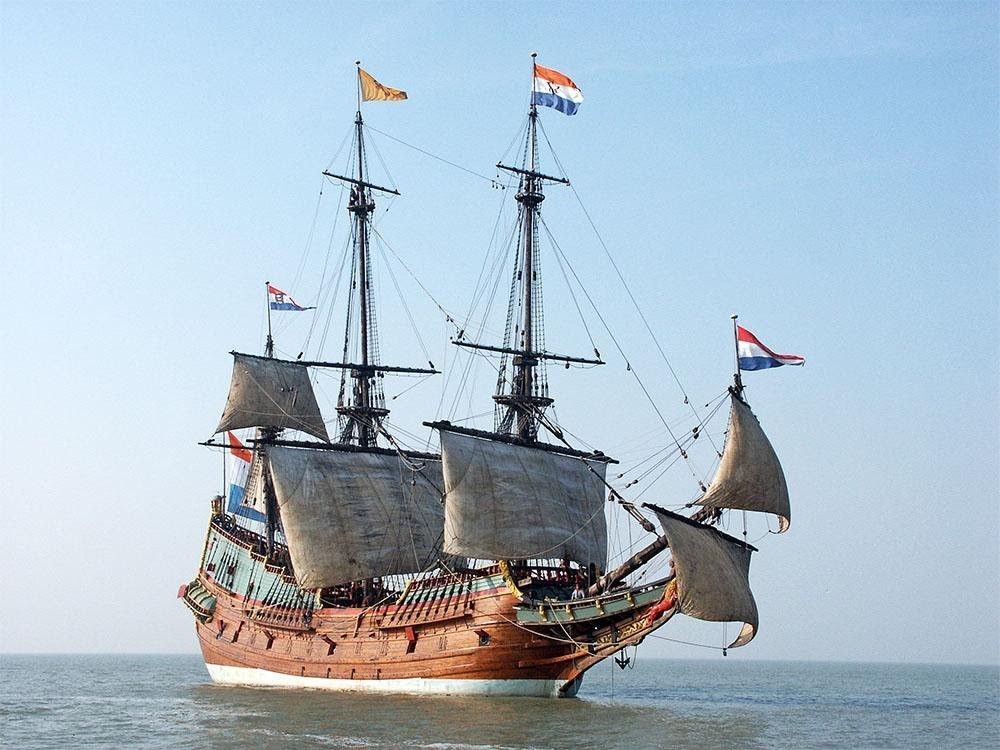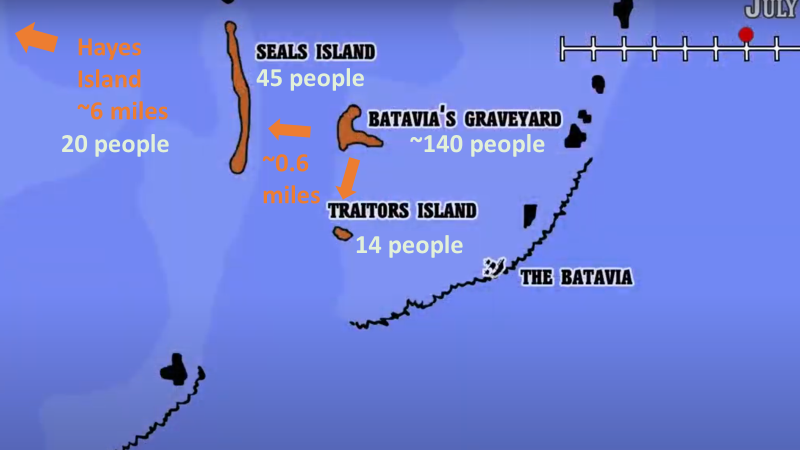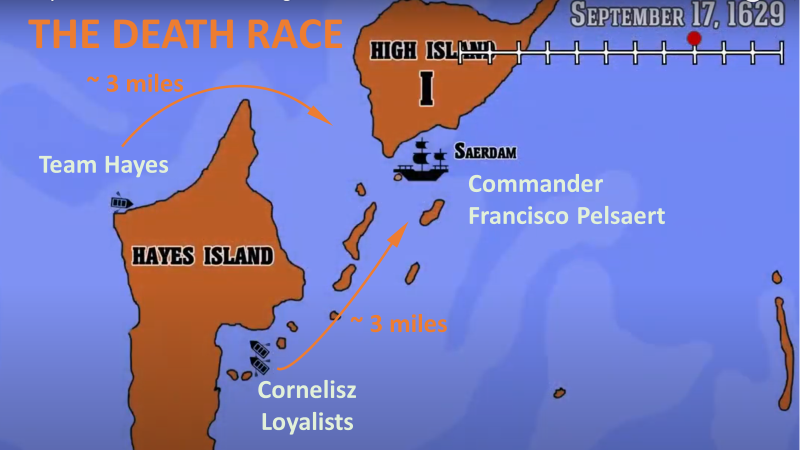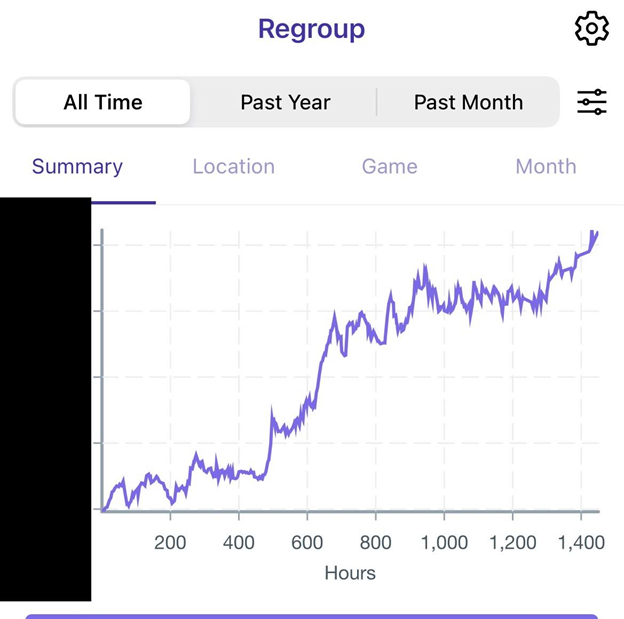Have you ever wondered what evil looks like up close? Or, have you considered what it would be like to be trapped in close quarters, for months on-end with a psychopath?
Well, all you have to do is read on to find out.
It’s the year 1628. Batavia is the brand-new flagship of the Royal Dutch East India company — the richest, most powerful corporation that the world has ever seen.
Batavia is the Titanic of her time. And like the Titanic, Batavia’s maiden voyage is doomed.
The ship sets sail from the Netherlands in October en route to modern-day Jakarta. Along with over 300 passengers, she carries an enormous amount of treasure for trade in the East Indies — eleven chests of silver coins and one chest of priceless jewels.

The voyage begins with drama. There’s drunken fighting, sexual assault, infidelity, jealousy, resentment, and greed. And amidst all this, a few men are plotting mutiny.
But before that mutiny can occur, the ship goes off-course. And in the early morning of June 4th, 1629, the Batavia runs aground on a rocky reef 50 miles off the west coast of modern-day Australia.
Shipwreck
Several days later, the ship falls apart. Fortunately, most people survive. About 230 make it onto a small, flat island about thirteen acres in size. The bad news is that there is no fresh water, and the survivors name the desolate island Batavia’s Graveyard.
Francisco Pelsaert, the commander of the Batavia, leads a small group in a small boat to explore surrounding islands for fresh water. No luck. The group heads east, toward modern-day Australia. There, they encounter huge cliffs. There is no way to venture on land for water.
Pelsaert’s boat follows the current north. And soon, they realize that their only option for finding help is to head toward the Dutch settlement in modern-day Jakarta. It’s about 1,800 miles away. Even if they make it there at all, it would be months before they can return to assist the survivors.
For now, the survivors on Batavia’s Graveyard must fend for themselves.
The psychopath emerges
Back on Batavia’s Graveyard, things seem to be improving!
It rains. Supplies from the shipwreck wash ashore. The survivors set up tents and rainwater collection devices. They catch birds, seals, and fish.
However, an unfathomable horror lurks ahead.
Jeronimus Cornelisz is one of the survivors on the island. Back in the Netherlands, his business had failed, and he left in disgrace.
Before the shipwreck, he was one of the ringleaders of the mutiny that never occurred. Many know about the mutiny. Even if the survivors are rescued, word of the planned treachery would likely leak, and Cornelisz will certainly be executed.
Cornelisz is a man with nothing to lose.
In addition, he has a twisted view of morality. He believes that he is special — a member of God’s elect. Everything this special group does is inspired by God. And as such, everything he can possibly do — theft, murder, rape, you name it — is moral.
Cornelisz is highly charismatic. Men are drawn to his persuasive tongue and heretical beliefs.
He convinces a few other mutineers of an audacious plan: when a rescue ship arrives, capture it, kill their leaders, and become pirates.
One problem: there are only 20 mutineers and over 200 others. They are outnumbered more than ten to one.
Cornelisz’s simple solution: kill the others.
Seizing power
On the island, Cornelisz happens to be the highest-ranking officer from the ship.
Due to his rank, he has a seat on the island’s leadership council. He decides that he needs to eliminate his most dangerous opponents.
With his artful tongue, he convinces the group that it makes sense to fan out to other islands to gather resources and maximize chances of survival. Of course, Cornelisz decides who goes where.
Given the large amount of treasure aboard the Batavia, she carried a large contingent of professional soldiers. One of the survivors is a soldier named Wiebbe Hayes. Hayes has proven to be a capable leader, getting things under control in the chaotic aftermath of the shipwreck and inspiring loyalty.
Cornelisz sees Hayes as a threat. Here is a man who is not only an experienced fighter, but also a natural leader.
Hayes must be eliminated.
So Cornelisz orders Hayes to take twenty of his most trusted fellow soldiers with him and embark on a mission to other distant islands to look for water.
Unbeknownst to Hayes and his men, they are on a suicide mission.
Cornelisz is certain that there is no water to be found. Hayes is not allowed to take any weapons, and he doesn’t get to keep a boat. In effect, he is trapped. Cornelisz expects Hayes and his men to die very soon.
At the same time and in similar fashion, Cornelisz strands sixty others onto two nearby islands: Traitors Island and Seals Island.

Escalation of atrocities
Cornelisz has made heinous progress. There are now only 140 people on Batavia’s Graveyard, but the mutineers are still far outnumbered.
Also, supplies remain precarious, and there are too many mouths to feed.
Again, Cornelisz’s solution to both problems is simple: keep killing.
Cornelisz’s henchmen begin by secretly luring people out to sea in boats.
“Hey! We’re heading across the sea to help Wiebbe Hayes look for water — you should come with 😉 “
Midway through the journey, and out of sight, the gang ties up the victims and tosses them overboard to drown.
Pretty soon, it’s obvious to everyone what’s happening. There are far too many freak accidents and disappearances.
Sometimes the murderers take three people out to sea, and after they tie up and drown the first two, the third begs for his life — willing to do anything to survive. Such men are later forced to kill to prove their loyalty.
Via brutal initiation rituals such as these, Cornelisz’s gang grows.
In time, the gang starts openly murdering people. Anyone who isn’t a mutineer or critical for survival is fair game.
Sometimes it’s a victim that a gang member simply dislikes.
Sometimes the victim’s only offense is that he is sick.
People are terrified. Cornelisz’s men are still vastly outnumbered but they control all the weapons, and there is no organized opposition. For many, it’s either swear allegiance to the gang or be killed. And many do join their ranks.
A small handful of survivors on Batavia’s Graveyard are women. Several of these women are single or otherwise unprotected. Cornelisz purposely sent their husbands to other islands.
He forces these women into sex slavery for his followers, and he keeps the most beautiful woman for his private pleasure.
Path to escape
Amidst this terror, a small miracle occurs. Smoke suddenly emerges in the distance from Hayes Island. It’s the signal that — three weeks into what was supposed to be suicide mission — Hayes and his men have found water!
The fourteen people that Cornelisz sent to die on Traitors Island have also managed to survive. That smaller group even built two rafts, and they immediately start paddling toward Hayes Island.
Unfortunately, Traitors Island is very close to Batavia’s Grave. Cornelisz’s men see these rafts, and decide that this cannot be allowed. They quickly send a detachment in a faster boat to take care of the problem.
The heavily armed men catch up to the rafts, overpower the weaponless crew from Traitors Island, and eventually kill them all.
Later, Cornelisz’s men massacre the majority of Seals Island’s defenseless population.
Their victims include pregnant women and children.
Over the coming days, a few survivors from Seals Island do make it to Hayes Island, clinging to various makeshift rafts and driftwood. And a few people manage to escape from Batavia’s Graveyard as well.
As refugees arrive with their tales of terror, Hayes and his soldiers are shocked. They immediately start preparing defenses.
Battle
Cornelisz is worried. His plan to capture the future rescue ship relies on the element of surprise. Now, thanks to one particular escapee, Hayes and his soldiers have a boat. They can intercept and warn a rescue ship before Cornelisz can execute his plan.
Meanwhile, Cornelisz rules over a gang of dangerous, bloodthirsty killers.
He orders the strangling of a baby.
His men murder the mother the night after.
They also massacre seven members of the ship reverend’s family.
Soon, the gang becomes restless. They are running out of people to slaughter. There aren’t enough survivors left to do basic chores. Now the killers even have to catch their own fish!
The situation would be comical if it isn’t so barbaric.
More importantly, Batavia’s Graveyard is running low on water.
Ironically, there is plenty of water and food on Hayes Island. Hayes and his men are both well fed and well prepared.
Cornelisz decides to send heavily armed men to Hayes Island to do what they do best: kill.
Hayes’ defenders have no guns or swords. However, they do have rocks and makeshift spears.
Twice team Cornelisz invades. The defenders throw rocks as the invaders wade ashore. Twice the invaders are forced to retreat.
Cornelisz can’t understand why his well-equipped men keep losing, so he embarks on a third attack. This time he personally leads the expedition. It’s a disaster. His top lieutenants are slain, and he gets himself captured.
Endgame
You might think that’s the end of the murderous rampage. But no!
One of Cornelisz’s remaining loyalists takes command. Two weeks later, this deputy leads a fourth and final attack. This time things are different. They bring two muskets.
The attackers realize that they can fire their guns from farther away than rocks can be thrown.
More methodically this time, the invaders inch their way toward shore, and one by one, Hayes’ men fall. There is nothing the defenders can do but retreat.
Soon enough, the invaders will reach land, and then all hope will be lost. There will be nowhere to hide. Things look grim.
Miraculously, at this critical juncture, a sail appears on the horizon. Against all odds, Francisco Pelsaert, the original commander, made it to modern-day Jakarta. He has returned with a rescue ship at the perfect moment, right during the heat of battle.
The date is September 17th, 1629, three and a half months since the Batavia ran aground on the coral reef.
Both sides scramble to their boats and row furiously toward Pelsaert. They converge from two different locations, roughly equidistant from the commander.
The stakes are enormous.
If team Hayes gets there first, all is saved. If not, the mutineers may be able to use the element of surprise to commandeer the ship, murder most of the crew, and then kill every remaining survivor.
It’s a boat race to the death. Everything depends on this outcome.

Fortunately, Team Hayes gets to Pelsaert first. Hayes quickly tells the commander what has happened.
Just in the nick of time! Soon thereafter, eleven heavily armed mutineers pull alongside Pelsaert’s ship.
Having been warned by Hayes, Pelsaert refuses to let them board. He aims the ship’s board cannon at them. After a tense standoff, the mutineers have no choice but to surrender.
Aftermath
Jeronimus Cornelisz is put on trial right away.
He shrewdly tries to pin the blame on others who are no longer alive, arguing that he was a victim forced to do their bidding.
It might be convincing if it isn’t for the overwhelming, damning testimony from everyone else. One by one, witnesses testify that Cornelisz is the ringleader of a gang that murdered over 100 people.
Eventually, Cornelisz is found guilty and sentenced to death.
Even as he awaits death, Cornelisz cunningly employs delaying tactics – asking to be baptized and for time thereafter to reflect on his sins.
Given Cornelisz’s persuasive abilities, who knows what might happen if he is kept alive for long? It’s a risk that Commander Pelsaert cannot take.
Pelsaert decides to execute Cornelisz immediately, alongside six of his most heinous accomplices.
A few other mutineers are marooned, and others are taken back to modern-day Jakarta for trial, bringing an end to this extraordinary tale.
Lessons for us
Jeronimus Cornelisz was a psychopath.
He possessed a twisted sense of morality and never displayed any sense of guilt. He was highly charismatic, intelligent, and manipulative.
I work in tech. In this industry, there are many famous examples of these charismatic, intelligent and manipulative CEOs. You know their names.
Some leaders use their psychopathic talents for good — inspiring people, building great things, and creating self-fulfilling prophecies. Others lead their companies to disaster.
Personally, I’ve also met a few individuals with traces of Cornelisz, although thankfully not to his full devious extent.
Like most personality traits, psychopathy is measured on a scale. And we’ve all encountered manipulative people in our lives. It’s hard to extract useful lessons from such a remarkable, but dated story. But at least you now have a few more warning signs to look out for.
I hope you’ve enjoyed this incredible but true tale. Here are a few great resources if you are interested in learning more:
- Trailer of a 4-part YouTube series by Defragged History. The narration, music, and graphics are superb. I can’t believe that this is a one-woman show. I will certainly watch more of her content in the years to come.
- An hour-long podcast interview of Mike Dash, who wrote the definitive book on the subject.
Thank you Cameron Zargar, Tom White, Michael Shafer, Mike Dash, and Yvette (Defragged History) for reviewing previous drafts of this article.
I primarily write at the intersection of investing, entrepreneurship and personal growth. And once in a blue moon, I write about history.



